MGNT603 Managing Finance: Scenario Analysis Report - University
VerifiedAdded on 2022/10/11
|6
|818
|11
Report
AI Summary
This report presents a scenario analysis focused on managing the Australian economy, addressing critical challenges such as public debt, the closure of automotive industries, and housing affordability. The analysis delves into the impact of these issues, including the effects of public debt on economic growth, the consequences of automotive industry closures on employment, and the challenges posed by housing affordability. Furthermore, the report examines the increasing unemployment rate and its impact on national income. It also explores the current account deficit, proposing solutions like increasing capital inflow and aid from international financial institutions. Finally, the report suggests strategies to increase GDP, including adjusting aggregate demand and supply, lowering borrowing costs, boosting investment, and improving education and infrastructure. The goal is to ensure a strong and sustainable economic future for Australia, as the report provides valuable insights for policymakers and stakeholders.
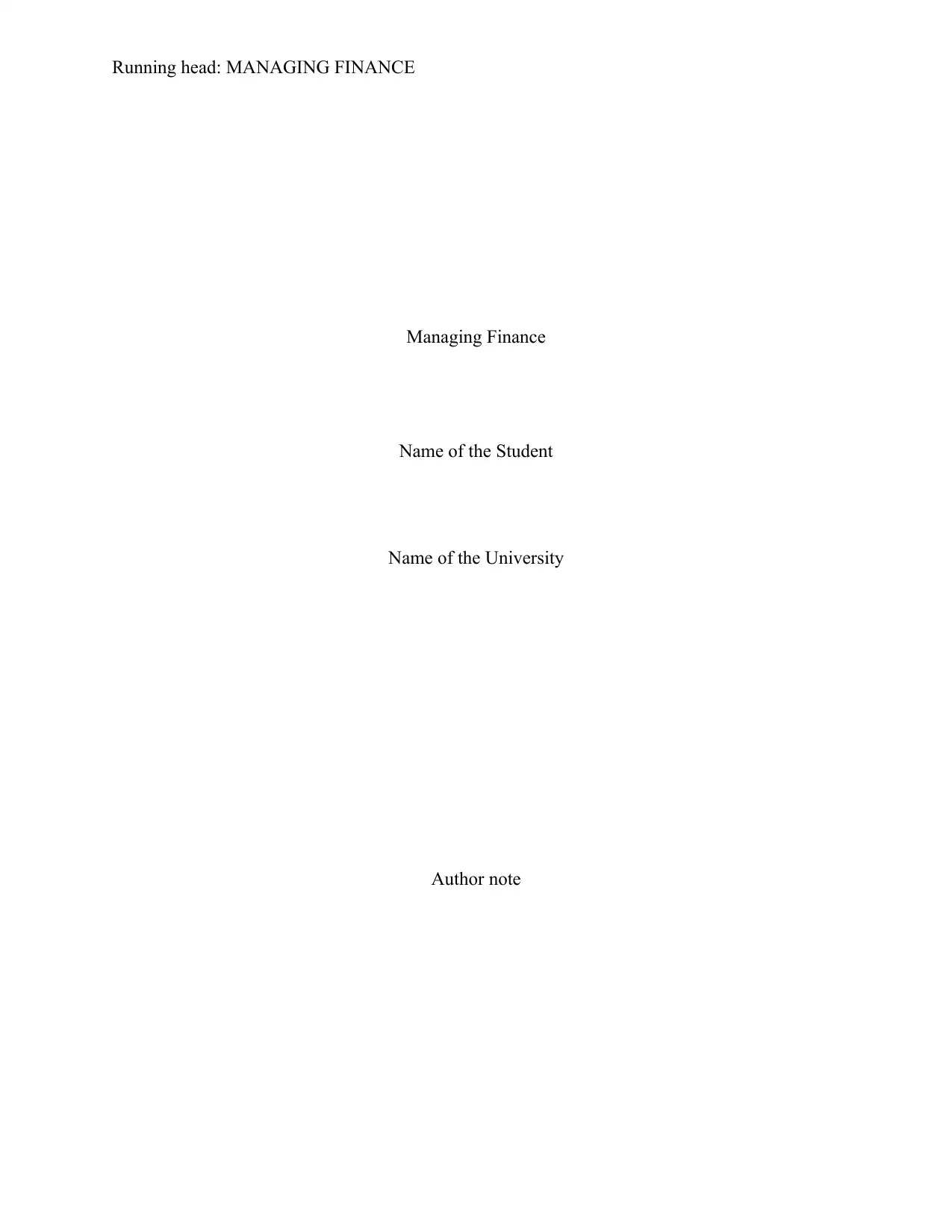
Running head: MANAGING FINANCE
Managing Finance
Name of the Student
Name of the University
Author note
Managing Finance
Name of the Student
Name of the University
Author note
Paraphrase This Document
Need a fresh take? Get an instant paraphrase of this document with our AI Paraphraser
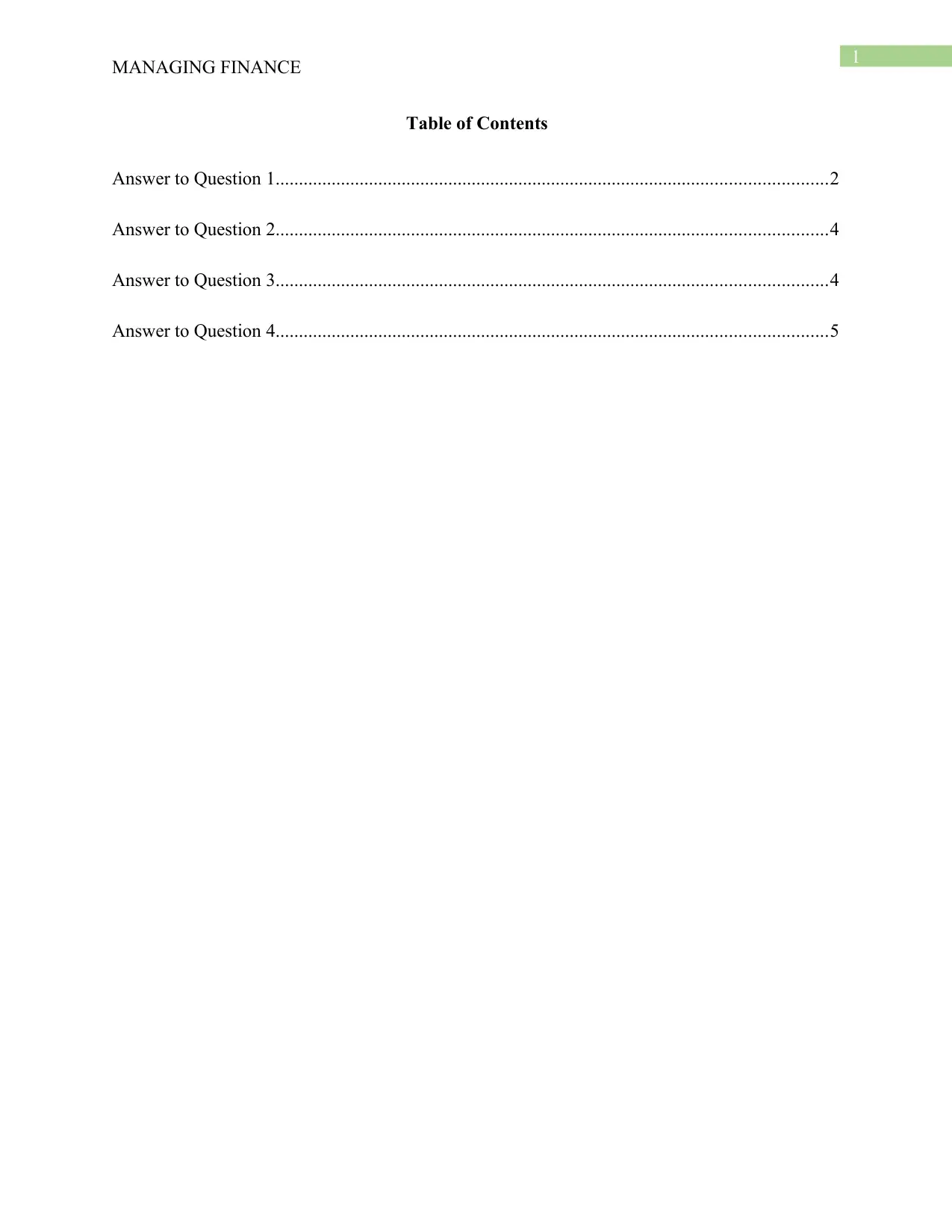
1
MANAGING FINANCE
Table of Contents
Answer to Question 1......................................................................................................................2
Answer to Question 2......................................................................................................................4
Answer to Question 3......................................................................................................................4
Answer to Question 4......................................................................................................................5
MANAGING FINANCE
Table of Contents
Answer to Question 1......................................................................................................................2
Answer to Question 2......................................................................................................................4
Answer to Question 3......................................................................................................................4
Answer to Question 4......................................................................................................................5
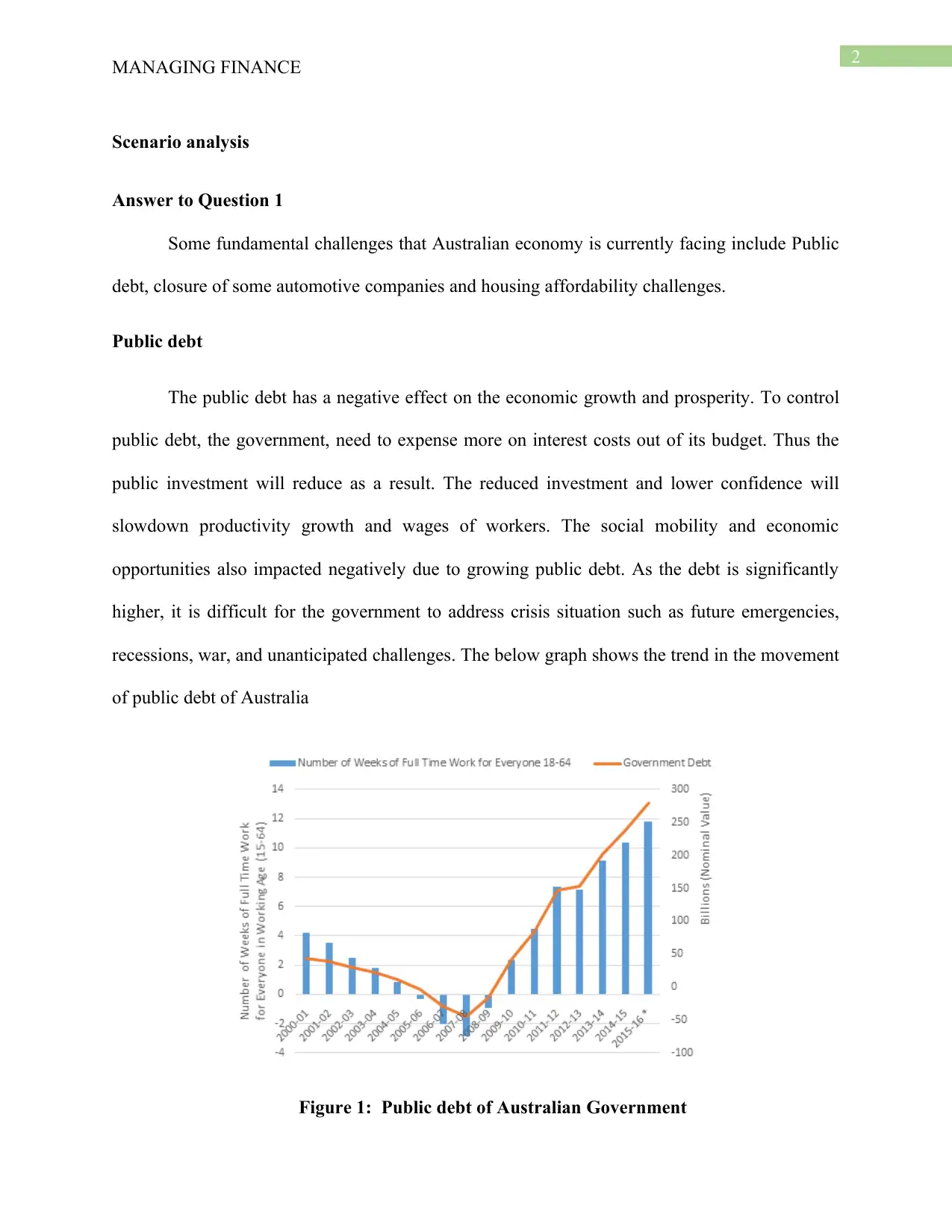
2
MANAGING FINANCE
Scenario analysis
Answer to Question 1
Some fundamental challenges that Australian economy is currently facing include Public
debt, closure of some automotive companies and housing affordability challenges.
Public debt
The public debt has a negative effect on the economic growth and prosperity. To control
public debt, the government, need to expense more on interest costs out of its budget. Thus the
public investment will reduce as a result. The reduced investment and lower confidence will
slowdown productivity growth and wages of workers. The social mobility and economic
opportunities also impacted negatively due to growing public debt. As the debt is significantly
higher, it is difficult for the government to address crisis situation such as future emergencies,
recessions, war, and unanticipated challenges. The below graph shows the trend in the movement
of public debt of Australia
Figure 1: Public debt of Australian Government
MANAGING FINANCE
Scenario analysis
Answer to Question 1
Some fundamental challenges that Australian economy is currently facing include Public
debt, closure of some automotive companies and housing affordability challenges.
Public debt
The public debt has a negative effect on the economic growth and prosperity. To control
public debt, the government, need to expense more on interest costs out of its budget. Thus the
public investment will reduce as a result. The reduced investment and lower confidence will
slowdown productivity growth and wages of workers. The social mobility and economic
opportunities also impacted negatively due to growing public debt. As the debt is significantly
higher, it is difficult for the government to address crisis situation such as future emergencies,
recessions, war, and unanticipated challenges. The below graph shows the trend in the movement
of public debt of Australia
Figure 1: Public debt of Australian Government
⊘ This is a preview!⊘
Do you want full access?
Subscribe today to unlock all pages.

Trusted by 1+ million students worldwide
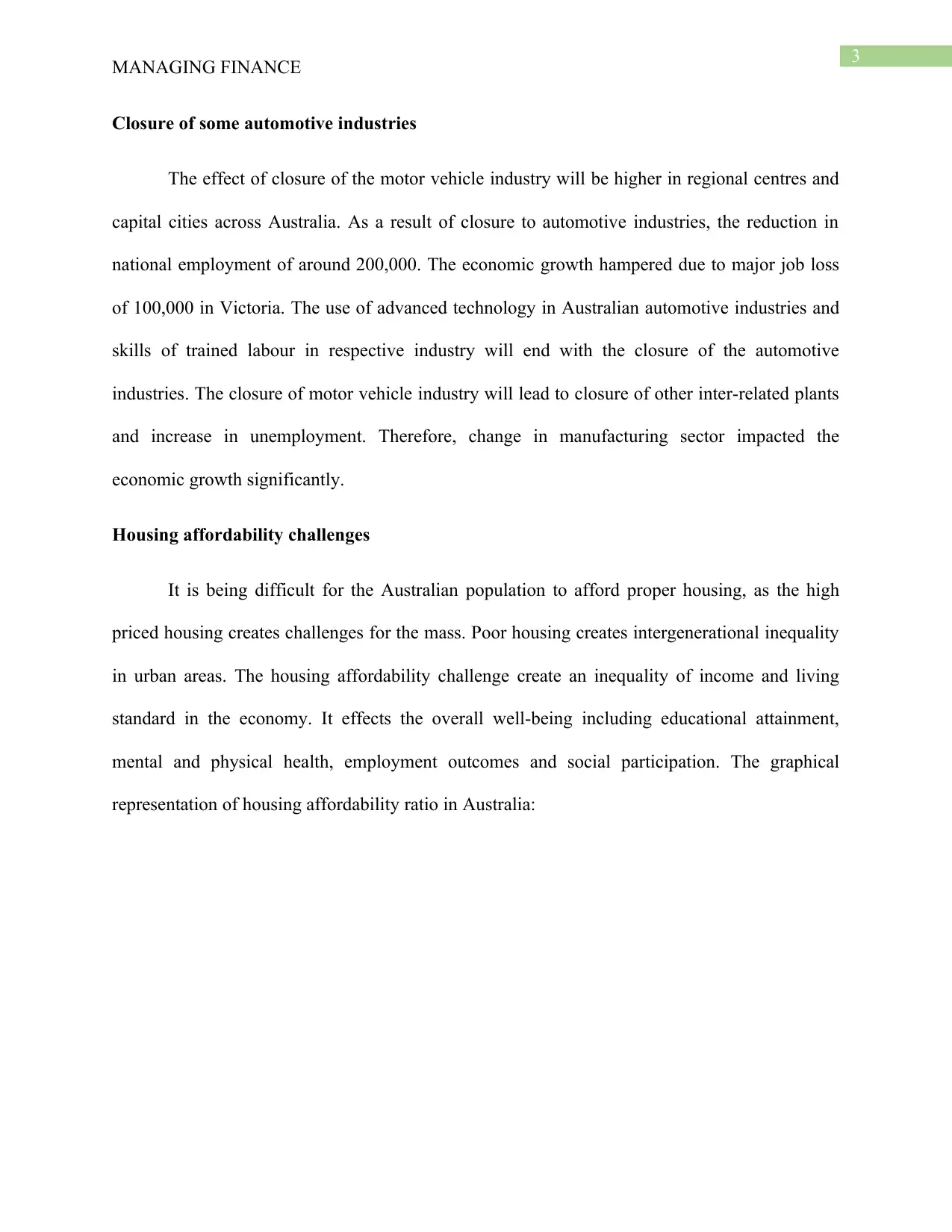
3
MANAGING FINANCE
Closure of some automotive industries
The effect of closure of the motor vehicle industry will be higher in regional centres and
capital cities across Australia. As a result of closure to automotive industries, the reduction in
national employment of around 200,000. The economic growth hampered due to major job loss
of 100,000 in Victoria. The use of advanced technology in Australian automotive industries and
skills of trained labour in respective industry will end with the closure of the automotive
industries. The closure of motor vehicle industry will lead to closure of other inter-related plants
and increase in unemployment. Therefore, change in manufacturing sector impacted the
economic growth significantly.
Housing affordability challenges
It is being difficult for the Australian population to afford proper housing, as the high
priced housing creates challenges for the mass. Poor housing creates intergenerational inequality
in urban areas. The housing affordability challenge create an inequality of income and living
standard in the economy. It effects the overall well-being including educational attainment,
mental and physical health, employment outcomes and social participation. The graphical
representation of housing affordability ratio in Australia:
MANAGING FINANCE
Closure of some automotive industries
The effect of closure of the motor vehicle industry will be higher in regional centres and
capital cities across Australia. As a result of closure to automotive industries, the reduction in
national employment of around 200,000. The economic growth hampered due to major job loss
of 100,000 in Victoria. The use of advanced technology in Australian automotive industries and
skills of trained labour in respective industry will end with the closure of the automotive
industries. The closure of motor vehicle industry will lead to closure of other inter-related plants
and increase in unemployment. Therefore, change in manufacturing sector impacted the
economic growth significantly.
Housing affordability challenges
It is being difficult for the Australian population to afford proper housing, as the high
priced housing creates challenges for the mass. Poor housing creates intergenerational inequality
in urban areas. The housing affordability challenge create an inequality of income and living
standard in the economy. It effects the overall well-being including educational attainment,
mental and physical health, employment outcomes and social participation. The graphical
representation of housing affordability ratio in Australia:
Paraphrase This Document
Need a fresh take? Get an instant paraphrase of this document with our AI Paraphraser
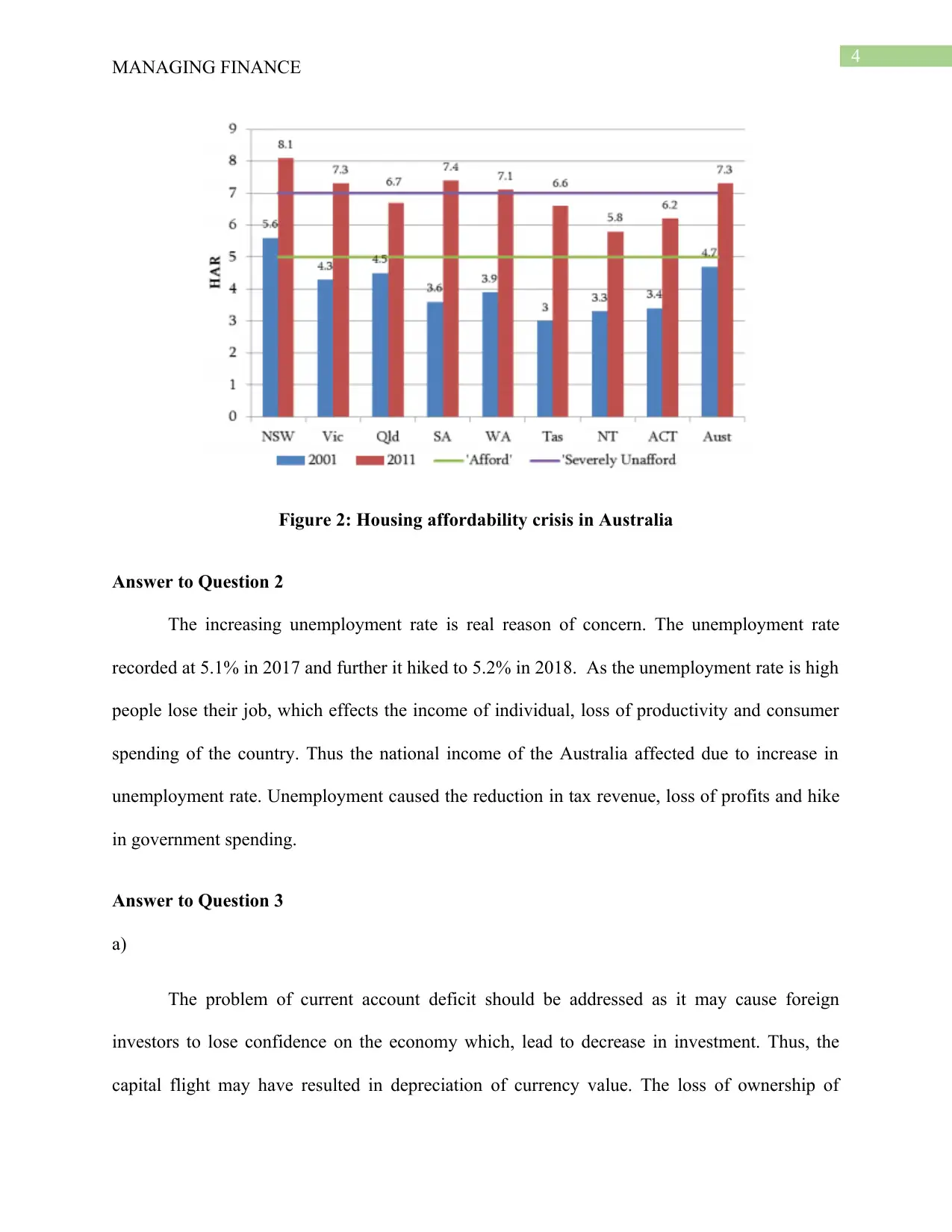
4
MANAGING FINANCE
Figure 2: Housing affordability crisis in Australia
Answer to Question 2
The increasing unemployment rate is real reason of concern. The unemployment rate
recorded at 5.1% in 2017 and further it hiked to 5.2% in 2018. As the unemployment rate is high
people lose their job, which effects the income of individual, loss of productivity and consumer
spending of the country. Thus the national income of the Australia affected due to increase in
unemployment rate. Unemployment caused the reduction in tax revenue, loss of profits and hike
in government spending.
Answer to Question 3
a)
The problem of current account deficit should be addressed as it may cause foreign
investors to lose confidence on the economy which, lead to decrease in investment. Thus, the
capital flight may have resulted in depreciation of currency value. The loss of ownership of
MANAGING FINANCE
Figure 2: Housing affordability crisis in Australia
Answer to Question 2
The increasing unemployment rate is real reason of concern. The unemployment rate
recorded at 5.1% in 2017 and further it hiked to 5.2% in 2018. As the unemployment rate is high
people lose their job, which effects the income of individual, loss of productivity and consumer
spending of the country. Thus the national income of the Australia affected due to increase in
unemployment rate. Unemployment caused the reduction in tax revenue, loss of profits and hike
in government spending.
Answer to Question 3
a)
The problem of current account deficit should be addressed as it may cause foreign
investors to lose confidence on the economy which, lead to decrease in investment. Thus, the
capital flight may have resulted in depreciation of currency value. The loss of ownership of
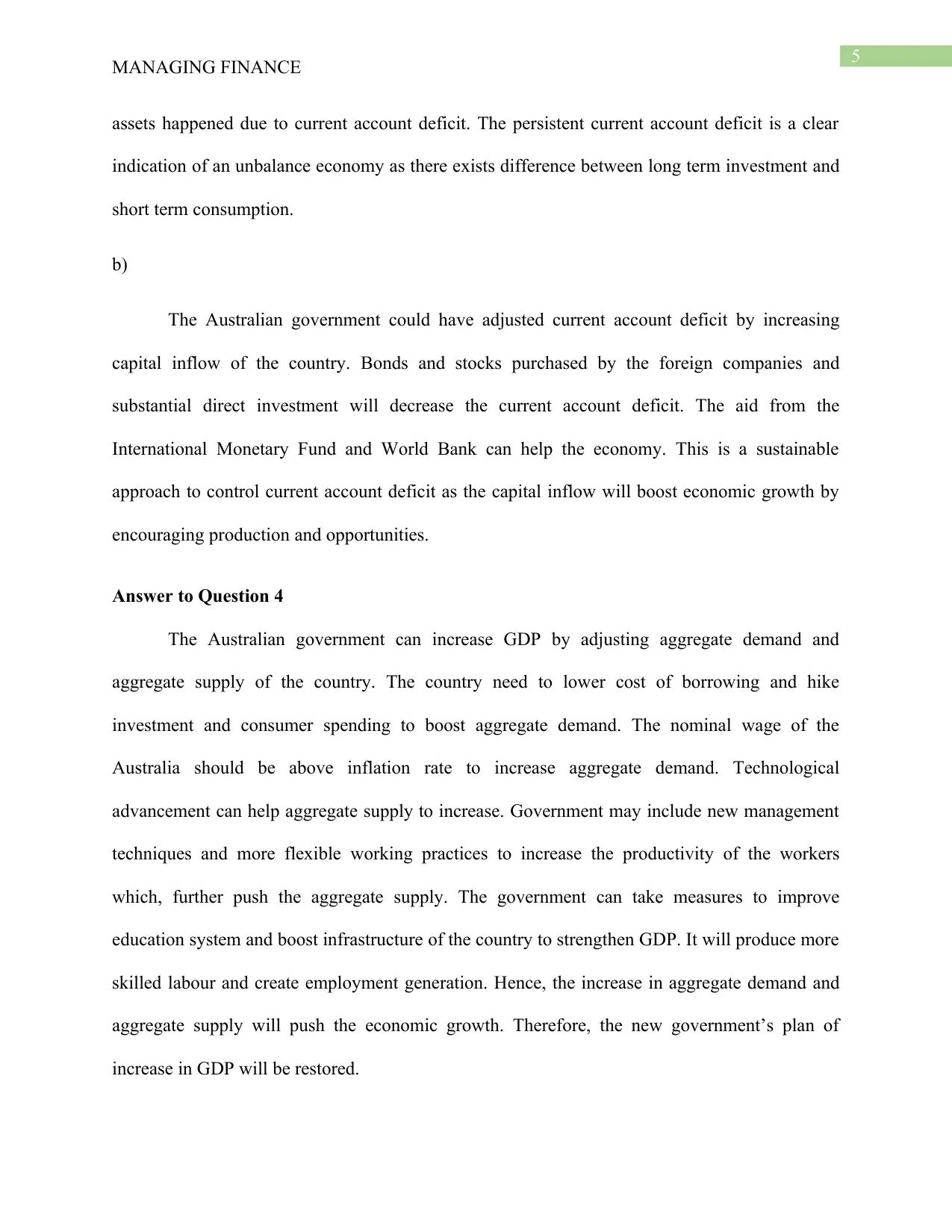
5
MANAGING FINANCE
assets happened due to current account deficit. The persistent current account deficit is a clear
indication of an unbalance economy as there exists difference between long term investment and
short term consumption.
b)
The Australian government could have adjusted current account deficit by increasing
capital inflow of the country. Bonds and stocks purchased by the foreign companies and
substantial direct investment will decrease the current account deficit. The aid from the
International Monetary Fund and World Bank can help the economy. This is a sustainable
approach to control current account deficit as the capital inflow will boost economic growth by
encouraging production and opportunities.
Answer to Question 4
The Australian government can increase GDP by adjusting aggregate demand and
aggregate supply of the country. The country need to lower cost of borrowing and hike
investment and consumer spending to boost aggregate demand. The nominal wage of the
Australia should be above inflation rate to increase aggregate demand. Technological
advancement can help aggregate supply to increase. Government may include new management
techniques and more flexible working practices to increase the productivity of the workers
which, further push the aggregate supply. The government can take measures to improve
education system and boost infrastructure of the country to strengthen GDP. It will produce more
skilled labour and create employment generation. Hence, the increase in aggregate demand and
aggregate supply will push the economic growth. Therefore, the new government’s plan of
increase in GDP will be restored.
MANAGING FINANCE
assets happened due to current account deficit. The persistent current account deficit is a clear
indication of an unbalance economy as there exists difference between long term investment and
short term consumption.
b)
The Australian government could have adjusted current account deficit by increasing
capital inflow of the country. Bonds and stocks purchased by the foreign companies and
substantial direct investment will decrease the current account deficit. The aid from the
International Monetary Fund and World Bank can help the economy. This is a sustainable
approach to control current account deficit as the capital inflow will boost economic growth by
encouraging production and opportunities.
Answer to Question 4
The Australian government can increase GDP by adjusting aggregate demand and
aggregate supply of the country. The country need to lower cost of borrowing and hike
investment and consumer spending to boost aggregate demand. The nominal wage of the
Australia should be above inflation rate to increase aggregate demand. Technological
advancement can help aggregate supply to increase. Government may include new management
techniques and more flexible working practices to increase the productivity of the workers
which, further push the aggregate supply. The government can take measures to improve
education system and boost infrastructure of the country to strengthen GDP. It will produce more
skilled labour and create employment generation. Hence, the increase in aggregate demand and
aggregate supply will push the economic growth. Therefore, the new government’s plan of
increase in GDP will be restored.
⊘ This is a preview!⊘
Do you want full access?
Subscribe today to unlock all pages.

Trusted by 1+ million students worldwide
1 out of 6
Related Documents
Your All-in-One AI-Powered Toolkit for Academic Success.
+13062052269
info@desklib.com
Available 24*7 on WhatsApp / Email
![[object Object]](/_next/static/media/star-bottom.7253800d.svg)
Unlock your academic potential
Copyright © 2020–2025 A2Z Services. All Rights Reserved. Developed and managed by ZUCOL.




